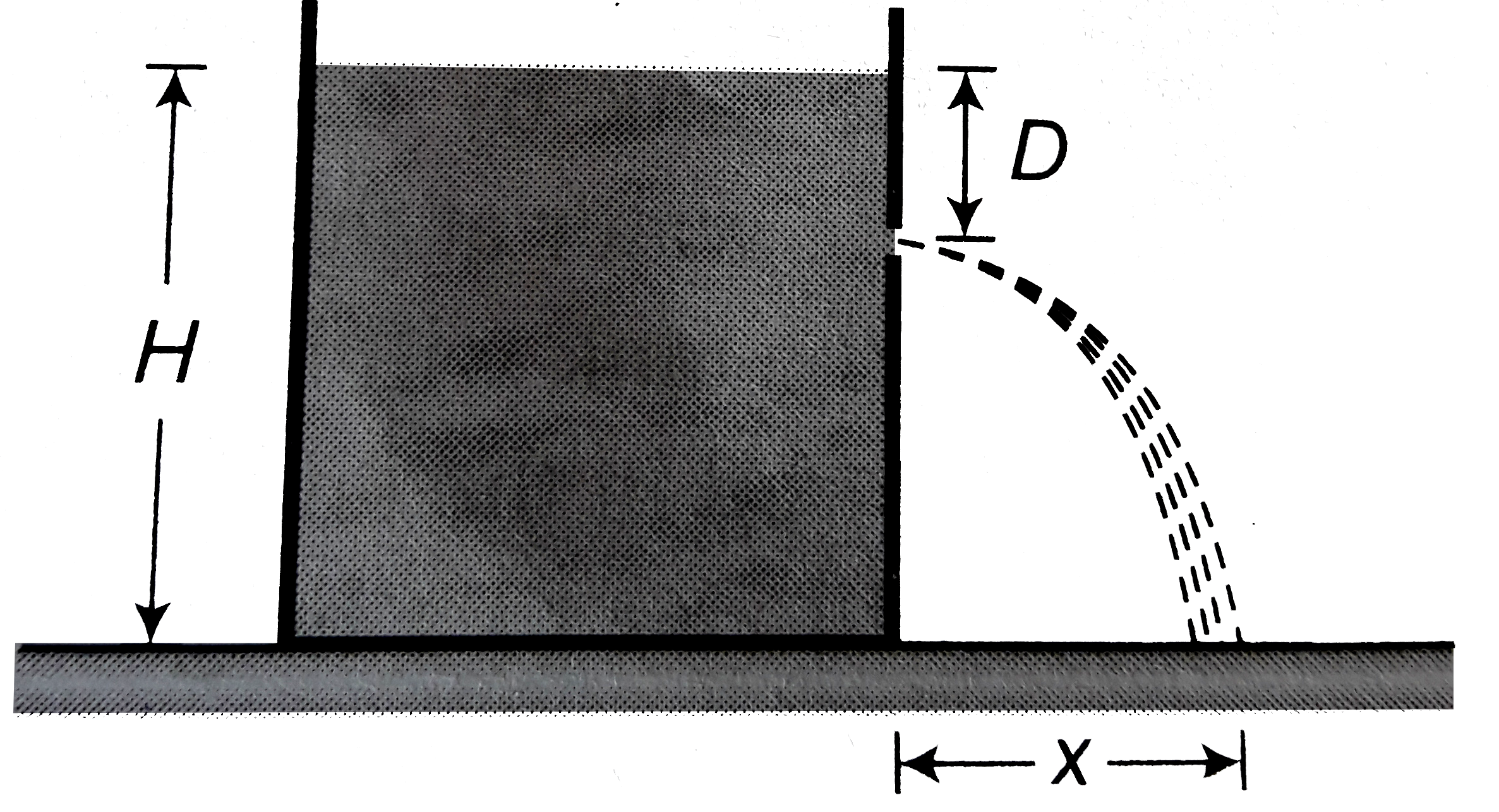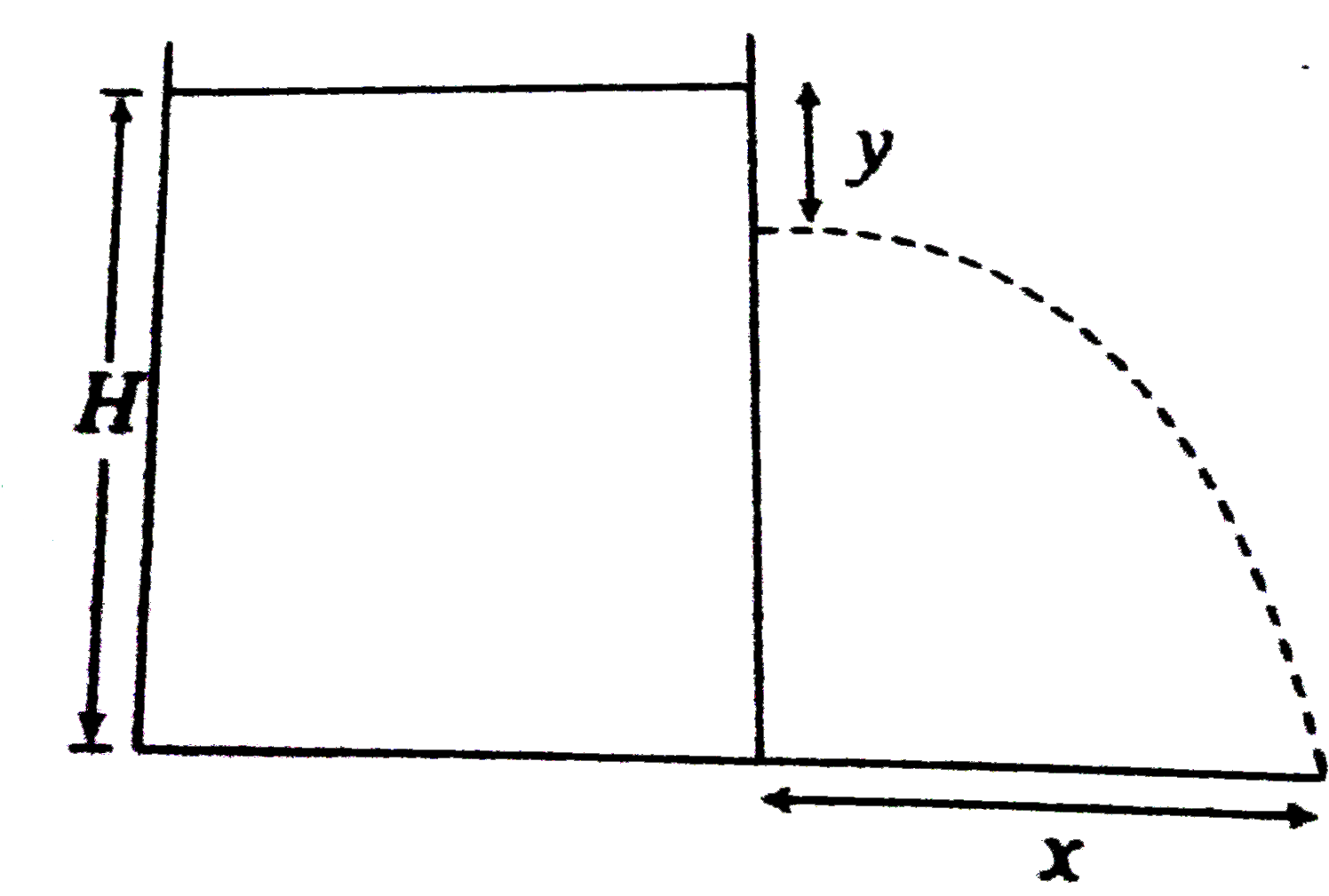The water is filled upto height of 12 m in a tank having vertical sidewalls. A hole is made in one of the walls at a depth 'h' below the water level. The value of 'h' for which the emerging stream of water strikes the ground at the maximum range is ___________m.
The correct Answer is:6
To solve the problem of finding the depth h below the water level at which a hole should be made in a tank to maximize the range of the emerging water stream, we can follow these steps:
Step 1: Understand the problem
We have a tank filled with water to a height of 12 m. A hole is made at a depth h below the water level. We need to find the value of h that maximizes the horizontal distance (range) that the water stream travels when it exits the hole.
Step 2: Determine the velocity of the water exiting the hole
The velocity v of the water emerging from the hole can be determined using Torricelli’s theorem, which states that the speed of efflux of a fluid under the force of gravity through an orifice is given by:
v=√2gH′
where H′ is the height of the water column above the hole. Since the total height of the water is 12 m and the hole is at depth h, we have:
H′=12−h
Thus, the velocity becomes:
v=√2g(12−h)
Step 3: Determine the time of flight
The time t it takes for the water to fall from the hole to the ground can be calculated using the equation of motion:
s=ut+12gt2
Here, s=h (the distance the water falls), u=0 (initial vertical velocity), and g is the acceleration due to gravity. Therefore:
h=0⋅t+12gt2⟹h=12gt2
From this, we can solve for t:
t=√2hg
Step 4: Calculate the range
The horizontal range R of the water stream can be expressed as:
R=v⋅t
Substituting the expressions for v and t:
R=√2g(12−h)⋅√2hg=2√h(12−h)
Step 5: Maximize the range
To find the value of h that maximizes R, we can differentiate R with respect to h and set the derivative equal to zero:
dRdh=2⋅12√h(12−h)⋅(12−2h)=0
Setting the term (12−2h)=0 gives:
12−2h=0⟹h=6
Conclusion
The value of h for which the emerging stream of water strikes the ground at the maximum range is:
6 m
We have a tank filled with water to a height of 12 m. A hole is made at a depth h below the water level. We need to find the value of h that maximizes the horizontal distance (range) that the water stream travels when it exits the hole.
The velocity v of the water emerging from the hole can be determined using Torricelli’s theorem, which states that the speed of efflux of a fluid under the force of gravity through an orifice is given by:
v=√2gH′
where H′ is the height of the water column above the hole. Since the total height of the water is 12 m and the hole is at depth h, we have:
H′=12−h
Thus, the velocity becomes:
v=√2g(12−h)
The time t it takes for the water to fall from the hole to the ground can be calculated using the equation of motion:
s=ut+12gt2
Here, s=h (the distance the water falls), u=0 (initial vertical velocity), and g is the acceleration due to gravity. Therefore:
h=0⋅t+12gt2⟹h=12gt2
From this, we can solve for t:
t=√2hg
The horizontal range R of the water stream can be expressed as:
R=v⋅t
Substituting the expressions for v and t:
R=√2g(12−h)⋅√2hg=2√h(12−h)
To find the value of h that maximizes R, we can differentiate R with respect to h and set the derivative equal to zero:
dRdh=2⋅12√h(12−h)⋅(12−2h)=0
Setting the term (12−2h)=0 gives:
12−2h=0⟹h=6
The value of h for which the emerging stream of water strikes the ground at the maximum range is:
6 m
Similar Questions
Water stands at a depth H in a tank whose side walls are vertical. A hole is made on one of the walls at a depth h below the water surface. Find at what distance from the foot of the wall does the emerging stream of water strike the floor and for what value of h this range is maximum ? What is the maximum possible range ?
View SolutionWater stands at a depth H in a tank whose side walls are vertical. A hole is made in one of the walls at a height h below the water surface. The stream of water emerging from the hole strikes the floor at a distance R from the tank, where R is given by
View Solution
Knowledge Check
- Question 1 - Select One
A tank is filled with water up to a height H. Water is allowed to come out of a hole P in one of the walls at a depth D below the surface of water. Express the horizontal distance x in terms of H and D
 .Ax=√D(H−H)Bx=√D(H−D)2Cx=2√D(H−D)Dx=4√D(H−D)
.Ax=√D(H−H)Bx=√D(H−D)2Cx=2√D(H−D)Dx=4√D(H−D) - Question 2 - Select One
A shell having a hole of radius r is dipped in water. It holds the water upto a depth of h then the value of r is
Ar=2ThdgBr=ThdgCr=TghdDNone of these - Question 3 - Select One
A cylindrical vessel is filled with a liquid up to a height H. A small hole is made in the vessel at a distance y below the liquid surface as shown in figure. The liquid emerging from the hole strike the ground at distance x
 Ax is equal if hole is at depth y or H-yBx is maximum for y=H/2CBoth (a ) and (b) are correctDBoth (d) and (d) are wrong
Ax is equal if hole is at depth y or H-yBx is maximum for y=H/2CBoth (a ) and (b) are correctDBoth (d) and (d) are wrong
Water stands up height H in a tank, whose side walls are vertical. A hole is made on one of the walls does the emerging stream of water strike the floor and for what value of h this range is maximum ?
View SolutionA tank is filled with water to a height H. A hole is punched in the wall at a depth h below the water surface. Find the distance x from the wall at which the stream strikes the floor. Could a hole be punched at another depth so that this second stream would have the same range? If so at what depth? For what value of h is range maximum?
View SolutionA tube is mounted so that it's base is at height h above the horizontal ground. The tank is filed with water to a depth h. A hole is punched in the side of the tank at depth y below water surface. Then the value of y so that the range of emerging stream be maximum is
View SolutionA tank with vertical walls is monted so that its base is at height of 1.2 m above the horizotnal ground. The tank is filled with water to depth 2.8 m. A holw is punched in the side wall of the tank at a depth x m below the surface of water to have maximum range of the emerging stream. then the value of x in metre is
View SolutionA rectangular tank is placed on a horizontal ground and is filled with water to a height H above the base. A small hole is made on one vertical side at a depth D below the level of the water in the tank. The distance x from the bottom of the tank at which the water jet from the tank will hit the ground is
View Solution

